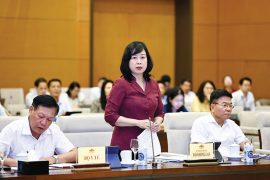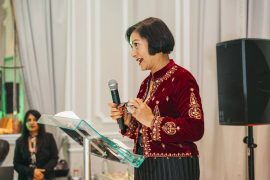“In this pandemic, we have witnessed new leaderships, individual and collective, which show that human beings have a great capacity to reinvent themselves and thus overcome adversity, no matter how painful or costly it may be. Women have proven it and I am sure that throughout each territory, in the midst of this crisis, those women heads of households, those women entrepreneurs, those neighbourhood or community leaders, those executives, those managers or those women leaders of organizations that have reinvented and challenged themselves, have appeared with a redoubled sensitivity and keen intelligence”. These were the words of Mrs Artola, the General Manager, Central Bank of Ecuador whicle discussing the topic – Building Back Transformed Economies Post COVID 19 in an Exclusive interview with the Amazons Watch Magazine.
Excerpts:
In the last ten months, the world has had to deal with the coronavirus pandemic, which affected most major cities and nations’ economies. Countries have put in place several measures to mitigate the impact of the pandemic on their economies and vulnerable populace. What steps has the Central Bank of Ecuador taken to cushion the impact of the pandemic on the nation’s economy and population; are and there specific programmes targeted at women-led businesses which often come off as the worst-hit such situations?
The range of action of the Central Bank of Ecuador is limited due to the impossibility of issuing money given the scheme in place in the country: dollarization. In this context, one of the main functions of the Central Bank of Ecuador is to ensure payments from the public and private sectors, which is why all the efforts made by our institution during the pandemic have aimed at implementing measures allowing to maintain the sustainability of the monetary system in the country.
Although the Central Bank of Ecuador does not have a specific program aimed at women, there are some initiatives in the country within the public sector: for example, the public bank BanEcuador keeps a line of credit open that aims at entrepreneurship or strengthening economic activities developed by women and women associations or organizations in situations of violence. Additionally, it maintains lines of credit for women in the rural sector through the “Super Rural Woman” product, whose target, as its name suggests, are women whose productive activity is family gardens or farms. This product seeks to promote inclusion, associativity and the improvement of the quality of life of women microentrepreneurs and their enterprises related to the area of agronomy.
In October 2020, the Central Bank of Ecuador signed a corporation agreement with the World Council of Credit Unions’ (WOCCU) – Economic Inclusion Project at promoting financial inclusion among the refugee population, as well as vulnerable residents in Ecuador. How will this cooperation contribute to Ecuador’s economic growth and aid in the activation of the country’s local and national economies Post COVID-19?
Ecuador is the country that has recognized the largest number of refugees in Latin America, of which more than 95% of them are Colombian. Furthermore, in Ecuador, there is a high number of applicants for refugee status, who are still awaiting a decision from the Government.
Integrating this segment of the population, as a target for actions that promote adequate financial inclusion, is aligned with the Government’s efforts to promote the cross-cutting of human mobility in national planning.
The Central Bank of Ecuador focuses on improving the country’s financial inclusion index, and in this way contributes to its productive and economic growth. For this reason, it keeps the constant challenge of enhancing the development of vulnerable sectors, especially refugees, giving them greater access to financial services, boosting the activities of small economies, and generating capacities to make optimal use of resources, increase their income and contribute to the activation of the economy in a national and local scale.
The role that cooperative savings and credit societies play in promoting financial inclusion is important, due to the proximity they have with the most vulnerable population, with openness capacities and with greater flexibility to adjust their products and policies to the generation of financial inclusion.
The inter-institutional convention signed with WOCCU aims to carry out coordinated actions to make information and training available and to implement programs, projects or plans that would impact the quality of financial inclusion and education, contributing to the development of economic and financial skills of different sectors of the population, allowing them to make the right decisions on financial and/or economic issues.
The COVID-19 Pandemic has fast-tracked, digital transformation across several sectors, significantly reducing human to human contact, while transforming services and businesses by replacing non-digital or manual processes across several sectors. Can this shift to technology present a better opportunity for women inclusion in socio-economic processes by eliminating gender bias and gender profiling?
Every transformation process implies innovation. First of all, it takes us out of our comfort zone, especially when we are faced with unexpected and extreme crisis situations, as is the case with this pandemic. Thus, in the current situation, we have been forced to modify behaviour patterns, implemented processes and habits that we had carried out in the same way, perhaps for years.
The day after the start of the quarantine, on March 17, suddenly throughout the country we were forced to face unprecedented situations, such as the very fact of seeing an entire institution learning to telework, to promote collaborative work processes at a distance, to break the mould of holding face-to-face meetings and relying more on technological solutions that the vast majority perhaps did not even know they existed, such as zoom or Webex, for example.
In this context, technologies have also become instruments that generate a new dimension for the exercise and expansion of rights. On the one hand, they allow access to information about different kinds of conflicts and gender gaps, such as learning experiences of female empowerment. But on the other hand, it offers the possibility of promoting new relationship dynamics at work, in education, in digital communities and in real ones, without using gender distinction or discrimination as a starting point. From this point of view, technology becomes an ally to eliminate and close gender gaps.
On the other hand, in the strictly socio-economic field, access to technology and the various tools and instruments it offers, opens doors for women to start their own projects. For instance, one of the most direct ways to break gender-based violence is for women to achieve economic independence.
Many times women are unable to break this violent circle due to obstacles in accessing credit, but the technological route can become an important path towards that desired financial freedom. Hence, it is important to find ways for entities and organizations that work on gender equity issues to promote initiatives, workshops and support mechanisms so that women can be trained in the best use of technologies, as an additional path in the pursuit of their empowerment. It is a new moment in history and it has emerged at a juncture that forces human beings to rethink their projects and how to build them. Technology today provides an opportunity to rethink by eliminating gaps and contributing to the creation of institutional and social cultures without discrimination, inequities and inequalities.
In a 2018 interview with Amazons Watch Magazine, you stated that the most important progress seen in Ecuador in terms of women’s participation in socio-economic and political activities is observed at the National Assembly where 38.69% of its members are women. How would you rate the progress of women’s participation in socio-economic and political activities in Ecuador now, two years later?
Two years ago I mentioned that in the political aspect there was an increase in female participation in Ecuador, but the results of the 2019 sectional elections suggest that this progress is still slow.
For example, out of the 221 municipalities that Ecuador has, only 18 were women who reached the Mayor’s Office (8% of the total), two more than in the 2014 elections, a result influenced by the lower female participation as candidates for the elections: out of 1,872 mayoral candidates, only 14.3% were women. Currently, there are 13 provinces in the country out of 24 where there are no women in charge in any of their cantons. Something similar happened in the provinces: out of 23 elected authorities, only four (17.39%) are women, two more than in 2014. To get there, 223 candidates participated and only 34 were women (18%). Finally, of 16 pairs qualified by the National Electoral Council for the presidential elections of 2021, only one candidate is a woman.
But the problem of the slow incorporation of women into the political arena is actually global. There are key countries in world geopolitics, that have not had a woman in the Presidency. For this reason, the World Economic Forum considers that world-wise it would take approximately 95 years to close the gender gap in political representation.
Precisely, the World Economic Forum (WEF) presents its Global Gender Gap Index every year and in the 2020 edition, it draws up a ranking with 153 countries evaluating them on four parameters: economic participation, educational achievements, health and political empowerment. In the sphere of politics, there are countries that show impressive achievements, such as Iceland, Norway or Finland, but even in those countries, the gap has not been completely closed. This WEF study indicates that of the 35,127 parliamentary seats distributed among 153 countries, only 25% are held by women. In women’s performance in political leadership positions, the gap is even wider: only 21% out of 3,343 ministers in 153 countries are women. In 85 out of the 153 countries, the presidential office was never held by a woman. In the case of Ecuador, it is ranked 48 in the ranking in political empowerment, below Nicaragua (position 3), Costa Rica (6), Mexico (14), Cuba (21), Argentina (22) and six more countries at a regional scale.
In the economic sphere, the role of women is also growing, but not at the expected rates. A study by the Deloitte firm, cited in a report by the Guayaquil Chamber of Industries, indicates with data from 2019, that only 9% of CEO positions in a company are held by women while only 7% are in COO. The figure is better for women in the position of General Management (24%) and 29% of shareholders belong to the female gender. On a global scale, the figures are not strong either. According to the World Economic Forum, only 18.2% of businesses are run by women.
Another topic of special attention is that of financial inclusion. Women represent 55% of the economically active population (EAP) in Ecuador, however, only 43% of this population has access to an account in the financial system, far below men. The figures show that Ecuador must move towards closing gaps, such as the financial one, because success in the fight for the eradication of poverty will also depend on it, within the framework of the Sustainable Development Goals (SDG).
For this reason, the Central Bank of Ecuador leads the collective construction of a National Financial Inclusion Strategy, with actions aimed at strengthening the entire country in general and the female sector in particular.
The SAMEAWS 2020 theme – Building Back Transformed Economies Post COVID 19:
The need for Inclusive Leadership, emphasizes the need for inclusive leadership. Drawing from the successes of female-led administrations in effectively responding to the pandemic, are their lessons learnt that can be codified into some playbook in building economic resilience in the face of major disruptions?
The pandemic made us measure our limits and also our capacity for resilience, not only individually but collectively. Thus, at different levels and based on different experiences, both men and women were trying out, inventing and assembling “on the fly” different responses to the crisis derived from the spread of covid-19 and its terrible impacts, not only in terms of lost human lives but in terms of deprived families, lost jobs, businesses going bankrupt and institutions without resources.
The pandemic has shown society the importance of different work dynamics, in order to make it easier for men and women to reconcile the professional and family spheres. An accurate strategy will allow us to spend more time with our children and perform more efficiently in our respective jobs. Now, more than ever, we have also witnessed the importance of teamwork in conflict solving. We must delegate and trust since in recent months our duties have been carried out remotely.
It is important to keep in mind that the long list of economic victims of the pandemic has women in the first ranks. Confinement made the female segment more vulnerable, especially due to greater exposure to situations of violence, job insecurity and less access to support systems.
Regarding violence and assaults, for example, in Ecuador, between March 12 and April 16, 2020, 7,954 alert calls for domestic violence were reported, an average of 256 calls per day. And between March 16 and September 14 of this year, in the midst of a pandemic and a state of emergency, there were 11,323 reports of women psychologically assaulted.
On the other hand, precarious employment in the midst of a context of generalized crisis such as that caused by the pandemic put women at a greater disadvantage. According to the Social Observatory of Ecuador, on average, women contribute 31 hours a week with activities at home, three times more than the help provided by men, which is 11 hours a week. This situation is aggravated because this double condition of being a working woman, which has made her carry the responsibilities in a company and at home, has affected her health. Data from the latest National Health and Nutrition Survey (2018) indicate that 46% of working women had obesity, 31% were overweighted and 32% had respiratory problems, exposing them as a group of greater risks against the threat of covid -19.
Hence, the State and society as a whole should think about the creation and strengthening of protection networks for the female sector, which should include not only the channelling of resources but also the strengthening of training plans, the promotion of innovation and access to credit.
In this way, hundreds and thousands of people were devising ways to overcome this terrible situation without losing sight of their surroundings, and that has made them leaders. In Ecuador, for example, we have come across citizen groups, such as Mujeres Progresistas, whose work area is carried out in the Trinitaria sector, in Guayaquil. Based on their belief in the organization as the basis for any project, they created a solidarity network to keep the largest number of female enterprises they supported active, also providing training and working to strengthen rights. They never let their guard down.
Consequently, as we emerge from the current crisis situation, perhaps one of the main lessons we can draw is that economic resilience is possible when three key elements come together: organization, solidarity and innovation. And this can be applied at all levels, from large institutions to smaller ones. Resilience, that ability to rise up in the face of adversity, must tend to gather experiences, capacities, intuitions and sensitivities to build something permanent and solid in the real world that one faces. Not all people can do it alone, which is why it is important to weave that resilience.
In this pandemic, we have witnessed new leaderships, individual and collective, which show that human beings have a great capacity to reinvent themselves and thus overcome adversity, no matter how painful or costly it may be. Women have proven it and I am sure that throughout each territory, in the midst of this crisis, those women heads of households, those women entrepreneurs, those neighbourhood or community leaders, those executives, those managers or those women leaders of organizations that have reinvented and challenged themselves, have appeared with a redoubled sensitivity and keen intelligence.





Comments are closed.